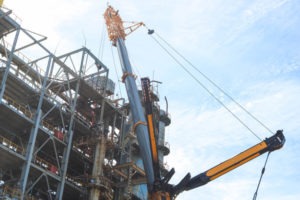Your Guide to Las Vegas Aerial Lift Accidents

Cranes and aerial lifts are an essential part of our national construction industry. When used correctly, they are great for hard-to-reach work and other precarious jobs up to about 45 feet in the air. However, when they are used incorrectly or when the workers operating the lift are not properly trained, it opens the door for a multitude of safety risks, including fatal falls or shocks.
According to labor statistics, an average of 26 workers in the U.S. die each year from aerial lift-related accidents. Employers or insurers may be unprepared for such accidents or may be unwilling to pay proper compensation. At Van Law Firm, our Las Vegas aerial lift injury attorneys can help you get back to full health and recover the reimbursement you deserve.
What are Aerial Lifts?
For a free legal consultation, call (725) 900-9000
Aerial lifts are mechanical pieces of equipment that enable workers to be raised up in the air, typically for use in outdoor settings; however, some smaller lifts may be used indoors in warehouse-type environments. The workers typically stand inside a metal “bucket” or on a small platform surrounded by railing, with operators on the ground either working the lift or assisting the workers with directions, instructions, etc.
These lifts are used for a variety of construction projects, from structural work to electrical and signage installations. There are multiple types of lifts which go by numerous different names– scissor lifts, man lifts, aerial ladders, boom lifts, and more. However, they all fall under the same designations in terms of workplace guidelines.
Aerial Lift Safety Guidelines
Click to contact our personal injury lawyers today
The Occupational Health and Safety Administration, or OSHA, is responsible for creating and enforcing all work-related safety standards. All of the regulations regarding aerial lifts can be found under OSHA 29 CFR 1926.453. These standards cover everything from fall prevention measures to how the equipment should be designed in the first place.
Some of the notable guidelines are as follows:
- A lift must not be moved while the boom is extended with workers in the bucket/platform, unless the equipment is certified for these functions.
- When outriggers are in use, the lift’s brakes must be set and the pads must be positioned on a flat, secure surface.
- Workers in the bucket/platform must wear a lanyard and a body belt that are attached to the bucket at all times when working.
- For articulating lifts (lifts that have multiple boom sections that can bend or “articulate,” allowing workers to travel not only vertically but horizontally as well) there must be controls both on the ground and in the bucket/ platform.
Complete a Free Case Evaluation form now
These guidelines also address “field modifications,” or any changes that are made to the equipment after it leaves the manufacturer– this is a very common practice among construction crews, in efforts to make equipment more efficient or comfortable. In order to be considered in accordance with OSHA guidelines, any modification to lifts must be “certified in writing by the manufacturer or by any other equivalent entity, such as a nationally recognized testing laboratory.” Any accident that is caused by an unauthorized modification becomes a huge liability risk for employers.
Risk of Electrocution
Falls may happen frequently, but by the numbers, the biggest potential danger for lift workers is electrocution. Due to the fact that power line maintenance is one of the biggest applications for aerial lifts, faulty equipment or improper operation can lead to a worker being raised up into or across an active power line. The lift itself may also strike a line or the operator may accidentally jolt the bucket, causing the worker(s) to fall or be thrown forward.
That is why electrical safeguards are some of the most important pieces of equipment on a lift. All lift buckets are expected to be very well-insulated, and operators are expected to have proper training or certification.
Potential Lift Accident Causes
An aerial lift accident may be caused by a number of different factors, including but not limited to:
- Defective or non-existent fall prevention equipment
- Moving the lift while it is elevated with workers inside
- Untrained or improperly trained personnel
- Defective lifts
- Failure to properly set brakes and prevent lift from moving
- Roughhousing or irresponsible horseplay
- Illegally modified lift equipment
- Failure to heed inclement weather
Lift Accident Liability
If an employer provides their workers with worker’s compensation, they are largely protected from liability for negligence. However, there are other parties who may be responsible for injuries resulting from lift accidents, such as:
- Any employer that behaved negligently and does not offer worker’s compensation
- An employee from a separate company who was the cause of the accident
- The lift manufacturer, if the lift is discovered to be defective
- The safety equipment manufacturer, if the fall prevention or shock prevention measures are discovered to be defective
Las Vegas Aerial Lift Injury Attorneys
If you’re the victim of an aerial lift accident, the Las Vegas aerial lift injury attorneys at Van Law Firm are the right choice to get you the treatment you need and the compensation you deserve. When you work with us, we’ll get you reimbursed and back to work as quickly as possible.
Call our Las Vegas office today at (725) 900-9000 to see what your case might be worth with a no-cost consultation. We’ve received hundreds of 5-star reviews so far– will you be the next?
No obligation consultations are always free.
Let Us Help You! Call Now: (725) 900-9000
